Contents
- General description of the shrub
- Types and varieties of goji
- How goji breeds
- How to plant goji berries
- How to grow goji berries
- Features of growing goji in different regions
- Is it possible to grow goji berries from seeds
- How to grow goji berries at home
- Diseases and pests
- Collection and storage of goji berries
- Conclusion
Goji berry – in recent years, this combination has been on everyone’s lips. Even for people far from gardening. And not everyone realizes that a plant that seems so exotic lives quietly in the wild in the vastness of Our Country, although mainly in the southern regions. The plant is not particularly whimsical, so planting and caring for goji berries in the open field of most regions of Our Country is quite accessible even to inexperienced gardeners.
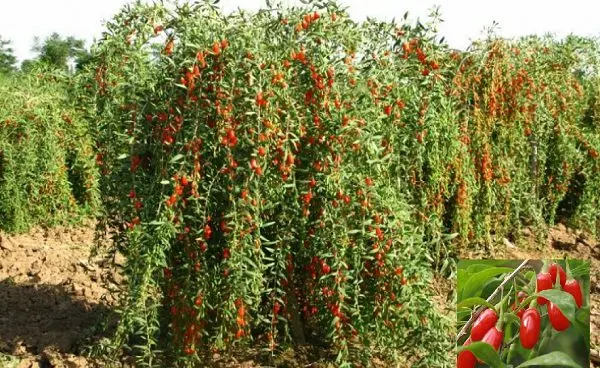
General description of the shrub
Such famous goji berries have a real, quite ordinary botanical name – dereza. The genus dereza is part of the Solanaceae family, which also includes many well-known garden crops: tomatoes, potatoes, peppers, physalis. There are two main types of wolfberry or goji berry: Chinese and common.
Chinese dereza originates from Tibet, which is currently an autonomous region of China. There it grows in the rather harsh conditions of the Tibetan Plateau.
If you pronounce the word “dereza” in Chinese, then the result will be something most consonant with the word “goji”. This is where the popular name of this plant comes from. Further in the article, it will be possible not only to find a description of the goji berry bush, but also to find out the features of planting and caring for it.
Another species is the common dereza, which in its properties is actually not much inferior to its Chinese sister. But it has a much wider area of distribution. It is ubiquitous throughout China, and in other countries of Southeast Asia, as well as in Central Asia, Ukraine, Primorye, and the Caucasus.
Dereza is a fairly tall shrub that can grow up to 3-3,5 m in height. The branches grow straight at first, but hang very quickly. On the shoots of gojim spines, the leaves are small, longitudinally elongated. The upper side of the foliage has a light green color, on the reverse side – a bluish tint. Leaves fall in winter.
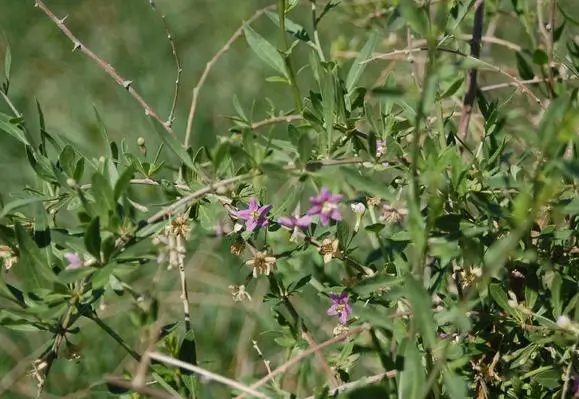
Goji berry plants have a powerful root system that can grow over considerable distances and form many root offspring. Therefore, in the southern regions of the dereza, it is also a goji berry, it is considered a malicious weed if it enters the territory of the garden. The crown can also grow well in width, eventually forming thickets up to 5 m in diameter.
The goji berry has many related folk names: Tibetan barberry, red medlar, Chinese wolfberry, and even wolfberry. All these names appeared, most likely, due to the shape and color of the berries. They really slightly resemble barberry berries, oval-oblong in shape and most often coral in color. Although the shades of different varieties may vary. In length, the largest berries can reach 12-14 mm. As a rule, they surround shoots in whole placers.
Depending on the variety and climatic conditions of the region, goji berries ripen between May and October. In China, during this time they manage to harvest as many as 13 crops. True, the most valuable berries in terms of their properties ripen in August-September.
How Goji Blooms
The goji berry shrub is able to bloom in favorable conditions as early as May and the flowering period continues until October. However, in the middle lane, flowering usually begins no earlier than June. Instead of faded flowers, berries soon form, but new and new buds form simultaneously on the shoots.
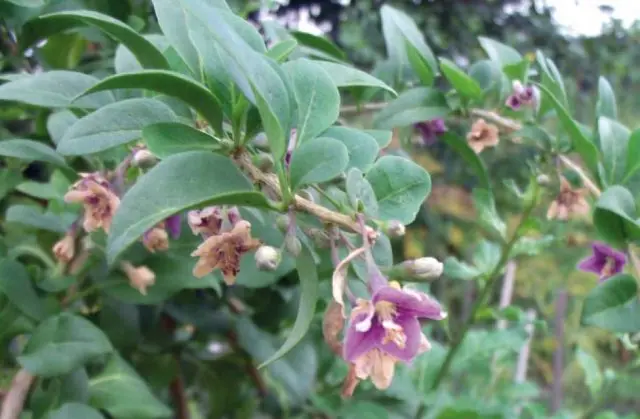
Goji berry flowers are small (1-2 cm in diameter), planted singly or 2-5 at once in the leaf axils. Their colors are violet-purple, the shape resembles a wide open bell or star. Flowers are characterized by a delicate pleasant aroma. They are visited by bees, collecting pollen and nectar.
The use of goji in landscape design
Goji berry plants, of course, look cute in the garden, but they are hardly decorative enough to attract everyone’s attention. They will look good in a hedge that encloses an area, or serves as a division of the garden into zones.

However, with the help of regular shearing, professional gardeners even manage to grow and form standard trees from plants, which look very elegant even as tapeworms.

Using the dangling form of shoots, goji berries can be grown in the form of a lignified vine, in the manner of grapes. In this case, when planting, plants should be provided with a stable support and periodically tie shoots to it. It is also important to cut them correctly, giving them the right growth direction.
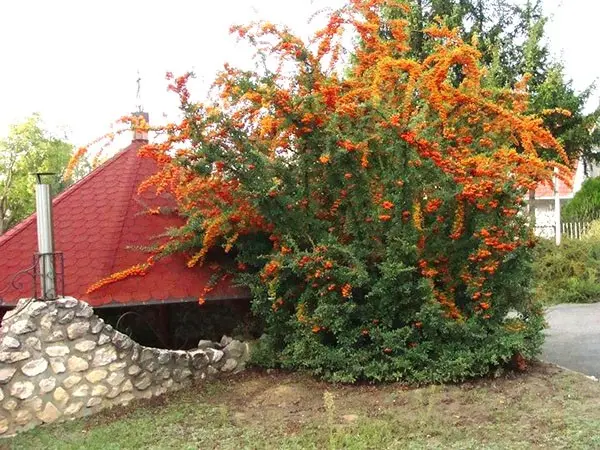
Due to the strong root system, goji berry plants are good to grow to strengthen the slopes, if any in the garden. But you should not plant them near the garden, so that later you do not have to deal with abundant root shoots.
Types and varieties of goji
In Tibet and China, there are at least 40 different varieties of goji berries. Since the popularity of this plant, European breeders have also done a lot in obtaining new interesting varieties of goji berries. The most unpretentious for growing and worthy of the attention of gardeners are the following varieties.
New Big
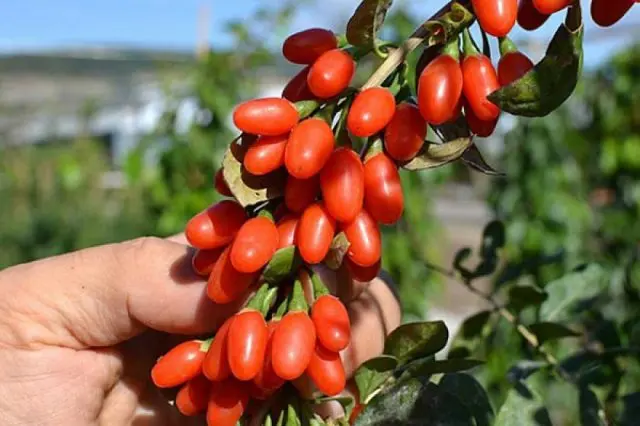
This variety is the fruit of the creation of breeders from Poland. Plants are able to bear the first fruits literally in the first year after planting. The variety is distinguished by powerful growth energy, in only one season its shoots can grow a meter in length. An additional advantage of the variety is a small number of thorns.
New Big is very resistant to adverse environmental conditions: it tolerates strong winds, heat and air pollution well. It is easy to grow even in the city. It is also resistant to frost – it can withstand up to -30-33 ° C.
The berries are sweet and large (up to 1 cm wide and up to 2 cm long), have a fiery red hue. They ripen from mid-August. In more northern regions, the ripening period for New Big goji berries may shift to September-October.
Lhasa
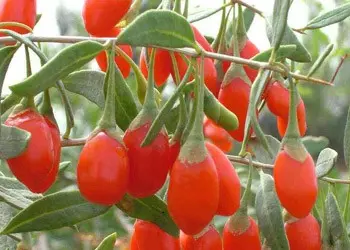
This variety, originally from China, also has an early fruiting period. Quite a tangible harvest can be obtained already in the second year after planting the seedling. Bushes reach a height of 300 cm, quite prickly. The fruits are large, sweet and sour with a barely noticeable bitterness in the aftertaste, rich orange in color. From one plant you can get from 3,5 to 4 kg of berries per season.
sugar giant
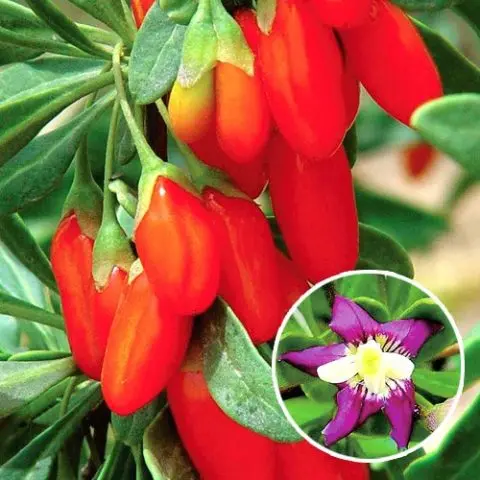
This variety has the largest fruits, up to 2,4 cm in length. True, they are formed only 3-4 years after planting. The bushes are also distinguished by a significant growth force, they grow well both in height and in width. The yield is impressive – up to 5 kg of berries per plant per season. The fruits ripen relatively late, from late August to October. The taste of the berries is very pleasant, sweet with a slight sourness. It is this variety that is most often referred to as the Tibetan barberry. It is also quite resistant to frost, the shoots are able to endure up to -30 ° C without freezing.
Sweet Amber
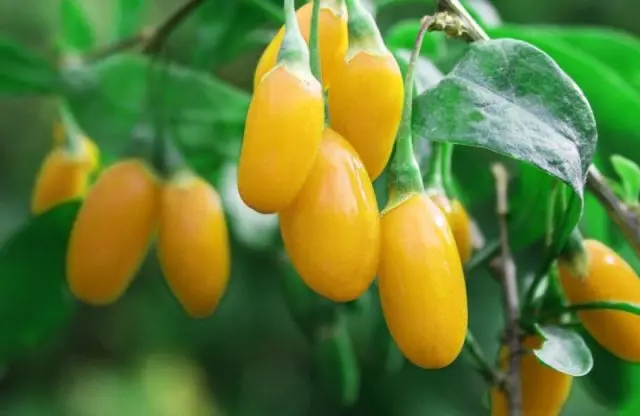
A fairly new variety of goji berries, bred in China only in 2016. Berries are distinguished by a special amber, translucent hue and almost honey taste. The fruits appear 2 or 3 years after planting, ripen in August-September. The plants themselves are not very large, reaching an average of 2,5 m in height. The variety makes special demands on lighting. Dessert taste of berries is guaranteed only in sunlit areas. Otherwise, it is also easy to grow, like other goji varieties.
Superfood
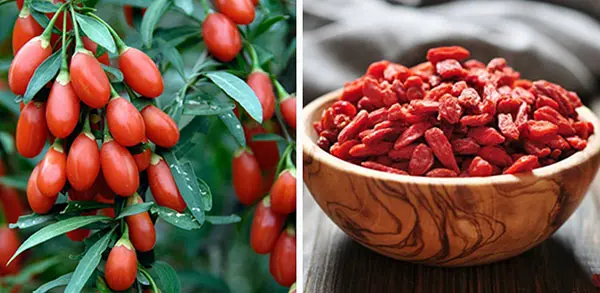
Bright red rather large berries appear on strongly leafy, slightly prickly branches for about 3 years after planting the seedling in a permanent place. The variety was obtained in Tibet. Bushes reach an average height of 300 cm, are frost-resistant, but demanding on sunlight.
How goji breeds
The goji berry plant can be propagated quite easily by almost all known methods:
- The seed method is the most popular because of its relative cheapness. But the plants begin to bear fruit only 4-5 years after sowing and do not always retain the properties of the mother plant.
- Goji plants that have reached the age of 3-4 years are propagated by layering, preferably after the first fruiting. In summer, it is enough to just dig in a part of the side branch and by autumn a new plant can be transplanted to a permanent place of growth.
- It is also easy to grow goji berries from cuttings. This requires segments of shoots from 15 to 20 cm long, with at least 3-4 buds. They are rooted in a greenhouse or under a bottle, and planted in a permanent place next season.
- The easiest way is propagation by root shoots. To do this, in late spring, they simply dig out one of the shoots growing near the mother plant.
How to plant goji berries
Goji berries are not at all demanding on the place of growth and care. Only young, newly planted plants will require some attention. It is more important to regularly limit both the growth of shoots with pruning and the growth of the root system.
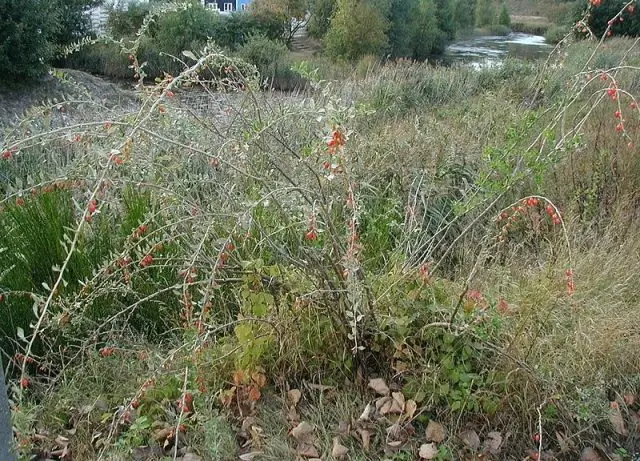
When to plant goji seedlings: in spring or autumn
In regions with a relatively mild climate, where autumn is warm and long, it is better to time the planting of goji berries to the autumn months. In the middle lane and in more northern regions, it is more reasonable to plant seedlings in the spring months so that the plants have time to take root better in a new place.
Site selection and preparation of soil
Most types of wild wolfberry are not demanding at all in choosing a growth site. Of course, they prefer a sunny location, but will easily put up with a little shade during the day. True, it is desirable to grow certain varieties exclusively in sunny areas.
Given the powerful root system of goji, they should not be planted near plants with delicate roots. Over time, the goji can easily crush them with its power. It is better to immediately dig slate or iron limiters into the ground so that the roots can spread over a large area. Or choose a place where goji can’t disturb anyone. After all, its requirements for the composition of the soil are minimal – plants can feel great even on stony and very poor soils. Soil acidity can be any. Although goji grows best on neutral or slightly alkaline soils.
Plants tolerate dry conditions well. Adult specimens are able to grow with little or no watering. But goji does not really like the close occurrence of groundwater. In these cases, it is necessary to create a good drainage layer during planting.
Preparing seedlings for planting
Goji seedlings are often offered for planting with a closed root system. In this case, they do not require any special preparation. Unless the soil in the containers is very dry. In this case, the entire pot should be dipped in a container of water for 30 minutes.
If the roots of the plant are bare and covered only with paper and polyethylene, then before planting they must be soaked for several hours in water at room temperature.
How to plant goji berries
Usually the process of planting goji seedlings in open ground is quite traditional. A few days before planting, a pit is prepared, about 30 x 40 cm in size. If water stagnates on the site, then it is necessary to create a drainage layer of gravel or brick fragments at least 15 cm high at the bottom of the pit.
Then a planting mixture is prepared from garden soil and sand in equal amounts with the addition of humus, wood ash and a handful of double superphosphate. Half the volume of the planting mixture is filled with a pit, a seedling is placed inside and the remaining amount of soil is filled up. Goji sapling is allowed to be slightly deepened when planting.
After planting, the goji bush is moderately shed and covered with a small amount of peat or chopped straw on top.

How to grow goji berries
For the successful cultivation of goji berry trees, it is recommended to follow only the most basic rules for care.
Watering Schedule
Young goji plants are most sensitive to watering in the first year after planting. They must not be overfilled. And during periods of heavy or prolonged rains, it is even recommended to protect the root zone with a piece of polyethylene. If there is no precipitation for a long time, then the seedlings, of course, need to be watered, but not more than 2-3 times a week. In the second year, goji can be watered regularly only in the hottest and driest weather. Mature plants usually do not need much watering.
When and what to feed
Goji is a very unpretentious plant and successfully grows and bears fruit even without additional dressings. But if you want to get particularly violent growth and a bountiful harvest, then in the spring you can feed the bushes with a complex fertilizer with microelements.
Loosening and mulching the soil
Loosening allows you to increase the access of oxygen to the roots, and at the same time free the root area from weeds. This is especially true for young plants. But mulching plays an even bigger role, additionally retaining moisture and preventing the sun from overheating the ground near the roots.
Pruning goji bushes
In the cultivation and care of the goji berry, pruning can play a special role in order not to grow what turned out in the photo.
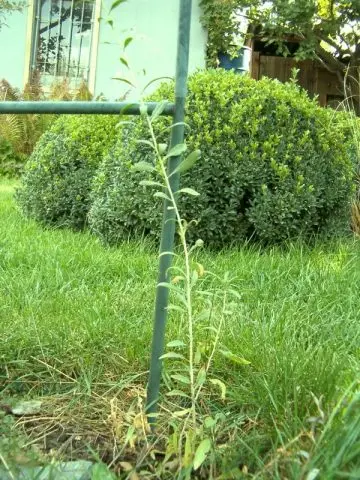
From the very first months and even weeks of life, goji shoots must at least be pinched so that they begin to actively bush. From them it is possible to form both a standard tree and a densely twisting liana.
In the first case, goji pruning begins in the spring, in the second year after planting, immediately after bud break. It is necessary to cut off all sprouts on the central shoot up to 1 m tall. Then the central shoot itself is cut off to stop growth at a height of about 1,5-2 m. All other branches are periodically shortened for more intensive branching.
In the second case, for goji, even when planting, it is necessary to provide a stable support from several pillars or a grid. It is necessary to tie all the main shoots to the support, periodically pinching their tips for branching.
To get the maximum yield, you should act differently. After all, you need to remember that the goji shoots of the last season are the most productive. Therefore, in the fall, when pruning goji, you can safely remove the fruiting shoots and those that are more than three years old. This will defuse the crown and the next year the bushes will bloom more abundantly.
Goji preparation for wintering
In areas south of Voronezh, goji plants do not require any shelter for the winter at all.
In other regions, it is necessary to proceed from the frost resistance of a particular variety and choose one or another type of shelter for the winter. The easiest way is to simply mulch the root zone with a thick layer of organic matter.
In especially frosty regions, branches are additionally covered with spruce branches or non-woven material.
Features of growing goji in different regions
You can grow goji berries in the country in almost any region of Our Country. The ability of goji to grow and feel good in different conditions is determined not so much by low temperatures in winter, but by the humidity of the soil and air. Since plants are more sensitive to waterlogging than to severe frosts.
In outskirts of Moscow
As a rule, in the conditions of the Moscow region, planting and caring for goji berry bushes do not require any special difficulties. There is even no need to somehow specially prepare the plants for the winter period. It is only advisable to cover the plants with the maximum amount of snow. You can additionally cover only young, just planted sprouts grown from seeds. You can use any organic mulch or peat for this.
In Siberia
Frosts in this region can be very severe. Therefore, in Siberia, it is necessary to thoroughly protect goji berry bushes from winter frosts, using any covering materials.
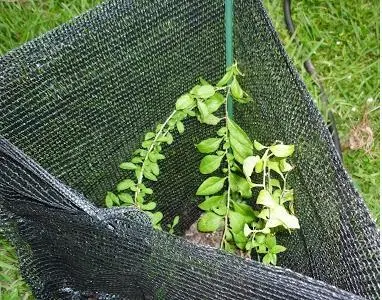
In particularly humid places, it is still recommended to move goji plants into containers and leave them for the winter in the basement or on the veranda. The main thing is that they have enough light in the winter.
In the Urals
In the Urals, frosts can also be very severe, but there is always quite a lot of snow. Therefore, if young seedlings are covered with spruce branches, and a lot of snow is thrown on top, then they may well endure wintering with dignity. The main thing is to make sure that during the period of massive snowmelt, the goji are not flooded.
In the Leningrad region
The Leningrad region is known not so much for cold winters as for high humidity and an abundance of swampy soils. Therefore, when growing goji berries, it is imperative to take care of a decent layer of drainage during planting, then caring for the plant will not cause any special problems. It is desirable to plant plants only on hills. With standard winter shelter, usually properly planted goji bushes survive even harsh winters well.
Is it possible to grow goji berries from seeds
Goji berries can be easily grown by sowing seeds extracted from fresh or even dried berries. It is only important that the berries are dried at a not too high temperature, not higher than + 50 ° C. Otherwise, shoots can not wait.
Under natural conditions, dereza is able to easily propagate by self-sowing.
How to grow goji berries at home
Each berry usually contains 8 to 15 seeds. Even if half of them come up, this is more than enough to get the required number of plants for your site.
When to Plant Goji Seeds
February or March is best for planting goji berry seeds at home. By the summer, the plants will already have time to get stronger, and they can even be planted in open ground.
Seeds do not need stratification, and if there is a special desire, then they can be sown almost all year round. For example, in late autumn, after the berries ripen. Only in this case it is necessary to provide additional artificial lighting for seedlings.
Preparation of containers and soil
Goji seeds are usually planted in boxes of suitable size, depending on their number. If adult dereza plants are unpretentious in relation to the soil, then seedlings in the first phase of their growth are very tender. For better germination, it is desirable for them to choose loose, but at the same time moisture-intensive soil. A mixture of 1 part of garden soil and two parts of peat is quite suitable. For ease, if desired, you can add a little sand to the earthen mixture.
How to plant goji seeds
Seeds before sowing, it is desirable to soak in a solution of growth stimulants. Although freshly harvested seeds already have a fairly high germination rate, up to 90%.
- After soaking, they are slightly dried and placed on the surface of the prepared slightly moist soil substrate.
- From above, the seeds are sprinkled with a small layer of earth, no more than a few mm thick.
- The surface of the substrate is sprayed again to create the necessary moisture.
- Then the box or container with the seeds is covered with plastic wrap to maintain the atmosphere of the greenhouse.
- Future goji plants do not need light before germination, but heat is necessary.
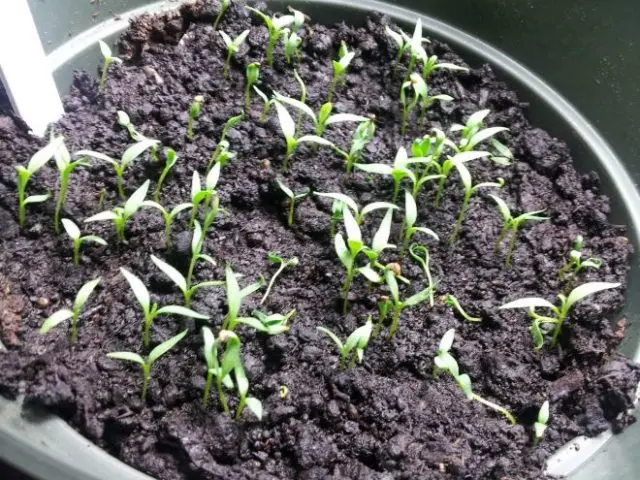
Germination can take 2 to 4 weeks. The sprouts appear very thin and tender. They immediately need good lighting, but for now they should be protected from direct sunlight.
In the period before the opening of a few true leaves, the main thing is to ensure that the soil in the box is constantly slightly moist. It cannot dry out, but excessive moisture will be unpleasant for young shoots.
How to grow goji at home
When young goji have 3-4 new leaves, the plants should be planted in separate pots.
Young goji do not need any top dressing in the first year. The main thing is to provide them with a sufficient amount of light, moderate temperature and humidity. After the first transplant, when the plants recover from stress, they can pinch the top of the shoot. You can grow goji at home. The plant does not require any special care. Only in winter is it better for him to determine the coldest place in the house. But for fruiting, he needs to find the sunniest place.

Shrub transplantation in open ground
Usually, strengthened young goji are planted in a permanent place in open ground already in late spring or early summer, when the danger of sub-zero temperatures is gone. At the same time, they operate according to the technology described above.
Diseases and pests
Since plants began to be grown relatively recently in the middle lane, pests have not yet had time to taste it. Being a representative of the nightshade family, the Colorado potato beetle sometimes attacks it. Aphids or some caterpillars, of course, like to eat young leaves. Insect control means are standard – spray the plant with one of the insecticides according to the attached instructions.
Of the diseases, only powdery mildew was noticed in especially rainy years, but it cannot cause severe harm to plants.
Collection and storage of goji berries
Despite the presence of thorns, it is very easy to collect goji berries. It is enough just to spread any matter or film under the bush and shake it by the branches. Ripe berries fall down and are easy to pick. After picking the berries, it is best to let them dry in a warm place, with minimal light, but at a temperature not exceeding + 50 ° C. Then fold for storage in glass jars or cardboard boxes. Store goji berries in a cool and dry place.
Conclusion
Planting and caring for goji berries in the open field should not cause difficulties even for novice gardeners. Meanwhile, this plant is capable of both decorating the site and helping to stock up tasty and healthy berries for the winter.









